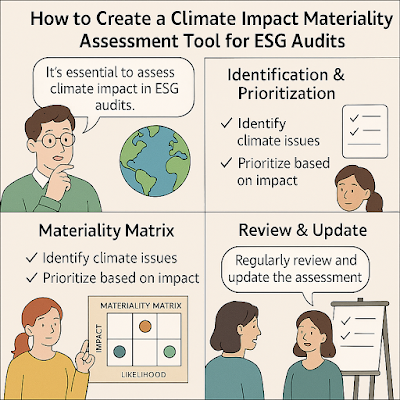How to Create a Climate Impact Materiality Assessment Tool for ESG Audits
How to Create a Climate Impact Materiality Assessment Tool for ESG Audits
In today's ESG-driven landscape, assessing the climate impact of business operations is no longer optional—it’s essential.
Building a Climate Impact Materiality Assessment Tool can empower organizations to identify, prioritize, and manage climate-related risks and opportunities effectively.
This guide walks you through the critical steps to create a practical and audit-ready materiality assessment tool.
Table of Contents
- Why Materiality Matters in ESG Audits
- Essential Components of a Climate Impact Materiality Tool
- Step-by-Step Guide to Building Your Tool
- Best Practices for Climate Impact Assessments
- Recommended Resources
Why Materiality Matters in ESG Audits
Materiality determines which climate impacts are significant enough to influence stakeholder decisions or the company's long-term value.
Investors, regulators, and consumers are increasingly scrutinizing ESG disclosures, making rigorous materiality assessments indispensable.
A well-structured materiality tool ensures that only the most relevant climate factors are prioritized during ESG audits.
Essential Components of a Climate Impact Materiality Tool
To design an effective tool, several key elements must be included:
Stakeholder Input
Gather perspectives from internal and external stakeholders to understand what climate-related issues matter most to them.
Impact and Likelihood Analysis
Evaluate both the severity of potential climate impacts and the probability of their occurrence.
Prioritization Matrix
Use a two-dimensional matrix to plot issues based on impact and likelihood, highlighting the most critical areas for action.
Documentation for Audit Trails
Keep detailed records of methodology, assumptions, data sources, and stakeholder inputs to support audit verification.
Step-by-Step Guide to Building Your Tool
Step 1: Define Scope and Boundaries
Identify which parts of your operations and value chain will be covered by the materiality assessment.
Step 2: Identify Climate-Related Issues
Leverage frameworks like TCFD, SASB, and GRI to compile a comprehensive list of climate-related topics.
Step 3: Engage Stakeholders
Conduct surveys, interviews, and workshops with stakeholders to gather diverse insights on climate impacts.
Step 4: Assess Impact and Likelihood
Use a standardized scoring system to evaluate each climate issue based on financial, operational, and reputational impacts.
Step 5: Prioritize and Visualize
Plot issues on a materiality matrix and generate visual reports for easier communication with executives and auditors.
Step 6: Review and Update Regularly
Materiality assessments must evolve as new climate risks emerge and stakeholder expectations shift.
Best Practices for Climate Impact Assessments
Here are some expert-recommended strategies to enhance the credibility of your materiality tool:
Use Third-Party Benchmarks: Compare your findings with external ESG standards.
Ensure Transparency: Clearly disclose your methodology and limitations.
Validate Internally: Seek cross-functional review and validation within your organization.
Emphasize Continuous Improvement: Treat materiality assessments as living documents, not one-off exercises.
Recommended Resources
For more insights and templates, check out these excellent resources:
By combining thoughtful stakeholder engagement, structured methodologies, and a commitment to transparency, you can create a Climate Impact Materiality Assessment Tool that not only strengthens your ESG audits but also drives meaningful environmental change.
Conclusion
Developing a robust climate materiality tool is an essential part of any forward-looking ESG strategy.
By following the steps and best practices outlined above, your organization will be better prepared to meet stakeholder expectations and regulatory demands.
Remember, the credibility of your climate disclosures depends heavily on the rigor of your materiality assessment process.
Start building your tool today and contribute to a more sustainable future!
Keywords: Climate Materiality, ESG Audit, Climate Impact Assessment, Sustainability Reporting, ESG Disclosure
